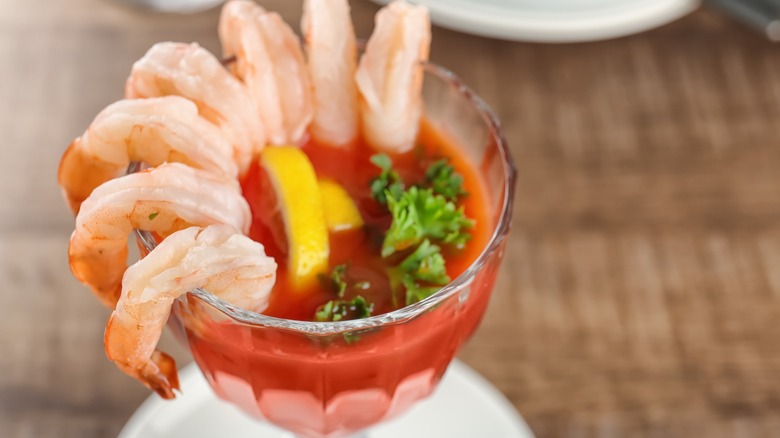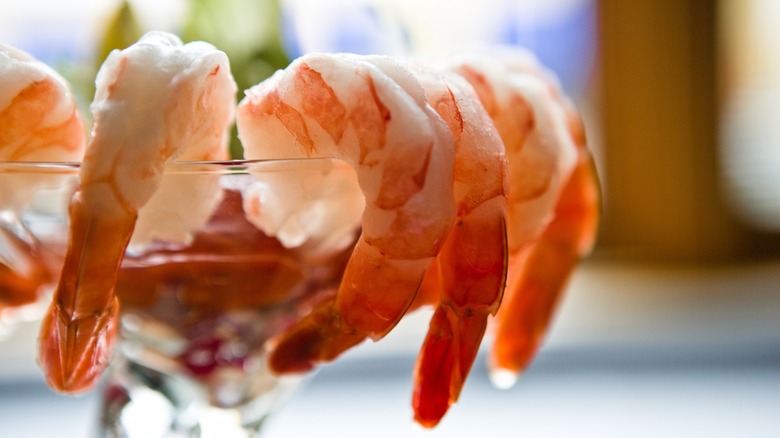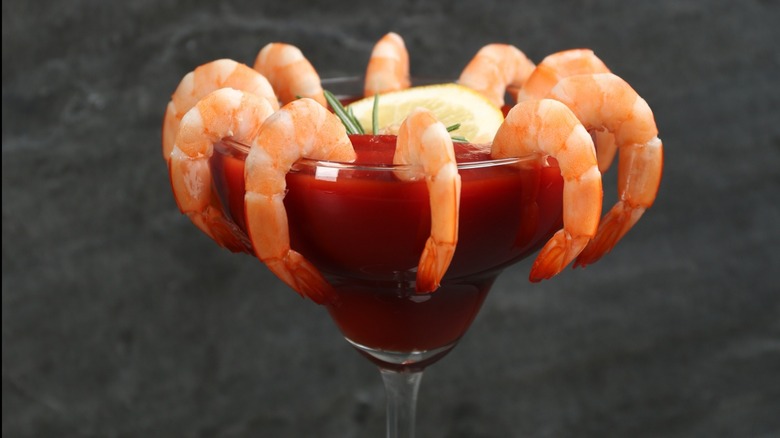The Prohibition Boom Of Shrimp Cocktail Sauce
Shrimp cocktail sauce is a hodgepodge of ingredients. The sauce brings together ketchup, horseradish, lemon juice, Worcestershire sauce, and Tabasco hot sauce in a slightly sweet, slightly spicy concoction that will make you feel like donning a fedora or flapper and heading out to the nearest speakeasy. "Cocktail sauce" is a bit of a misleading name since, despite all these varying mix-ins, the appetizer isn't made with alcohol. Instead, the name refers to the dish's prevalence in Prohibiton-era eateries and how it was served inside a cocktail glass.
In fact, shrimp cocktail sauce wasn't even originally paired with shrimp. Although recipes for the dish abound throughout the twentieth century, the first appearance of the dish may have been a couple of decades earlier in the nineteenth century, sometime after the California Gold Rush, at least according to culinary legend. The story goes that a miner sat down at a local San Francisco bar and ordered a glass of whiskey and a plate of oysters, which were cheap and plentiful at the time. After he finished his drink, he poured his oysters inside of the leftover glass along with some sauces that were lying around the bar and slurped it down. He called it his "oyster cocktail."
Shrimp in the roaring twenties
The San Francisco prospector story may not be entirely true, but it does demonstrate the legacy of cocktail sauce, a condiment so ubiquitous that its origins became shrouded in legend. What we do know is that an 1889 article in the Chicago Tribune reprinted a piece from the New York Sun about a San Francisco man teaching diners at the famed Manhattan steakhouse Delmonico's on how to construct an "oyster cocktail." This recipe, loosely defined as a "drink," contained the same ingredients that can be found inside cocktail sauce today.
The Prohibition years in the 1920s coincided with the rising popularity of cocktail sauce recipes in cookbooks. One entry from a 1926 collection entitled "Mrs. Allen on Cooking, Menus, Service" lists instructions for making a general "savory cocktail" sauce, which can be used with oysters, shrimp, and, if no seafood is available, mushrooms and sweetbread. Notably, Mrs. Allen points out that the dish should be served in a cocktail glass, referencing the way Prohibition-era restaurants made use of their then-empty drinkware. Cocktail appetizers presented this way, whether they were centered on shrimp, fruit, or any other snackable bite, were commonplace at a time when alcoholic drinks could no longer be served (legally, of course).
From Prohibition to Vegas
The 1920s also signaled the beginning of the end of the oyster and, in turn, the dawn of prawn. At the turn of the century, oyster supplies started to dwindle due to overharvesting, turning the shellfish from a working man's snack to an elite delicacy. Meanwhile, the rise of industrial refrigeration and railroad transportation meant that food suppliers could finally ship shrimp across longer distances.
Although Prohibition may have been the Golden Age of shrimp cocktail sauce, the appetizer had what may be considered a Silver Age in the casinos of Las Vegas beginning in 1959. Even though Prohibition had ended at this point, the tradition of serving the dish in a cocktail glass stuck around and found a dedicated clientele at Fremont Street's Golden Gate Casino before moving on to the rest of the city. Cocktail sauce may have been a staple of the Protestant Prohitibion movement, but it ironically continued its legacy in the smoky halls of Sin City's gambling dens.



